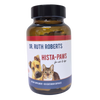If you’ve ever stood in the pet food aisle, staring at rows of shiny cans and bags, you’re not alone. One of the most common questions I hear from pet parents is:
“Is canned dog food good for dogs? What about canned food for cats?”
It’s a fair question, and one that doesn’t have a one-size-fits-all answer.
As a holistic veterinarian, I’ve spent decades helping families navigate the confusion. Some pets may thrive on canned food when fed wisely, and I’ve also seen the health challenges that come from relying too heavily on canned food, overfeeding out of love. Read the real story here.
Canned food can be a mixed bag. On one hand, it’s often better than dry kibble: it’s higher in moisture, easier to digest, and usually contains more real protein. That extra hydration is especially vital for cats, who naturally have a low thirst drive and are prone to urinary and kidney issues.
But there are also real concerns that pet parents should understand, from ingredient quality and packaging safety to cost and dental care. Like anything in holistic health, the key is balance, awareness, and tailoring your pet’s diet to their unique needs.
In this article, we’ll explore the pros and cons of canned food for dogs and cats, when it’s a good choice, and how to use it as part of a holistic nutrition plan that supports your pet’s long-term well-being.
Let’s dig in!
The Pros of Canned Food
Higher Moisture Content
This is a major advantage, especially for cats, who naturally have a low thirst drive. Many cats live in a state of chronic dehydration, which can lead to urinary tract issues or kidney disease. Moisture-rich canned food helps maintain hydration and supports healthy kidney and bladder function in both cats and dogs.
Fewer Carbohydrates
Canned foods generally contain fewer carbohydrates than dry kibble. This is especially beneficial for cats, who are obligate carnivores and not designed to process large amounts of starch. Lower-carb diets also support weight management and help regulate blood sugar, making canned food a good option for pets prone to diabetes or obesity.
Palatability
Canned food’s aroma and texture make it irresistible for picky eaters. For pets recovering from illness or with reduced appetite, canned food can be the key to getting them to eat again.
Fewer Preservatives
Since canned food is sealed and sterilized, it doesn’t require the same level of synthetic preservatives that dry kibble does. This means fewer artificial additives, which aligns with a holistic approach to cleaner, more natural nutrition.
The Cons of Canned Food
Ingredient Quality
Not all canned foods are created equal. Some contain fillers, artificial flavors, and vague “meat by-products.” Always read labels carefully, choose products with named proteins (like chicken, salmon, or beef) listed as the first ingredient, and avoid anything with chemical preservatives or unnamed animal ingredients.
Packaging Concerns
Most cans are lined with materials that may contain BPA or other chemical substitutes that can leach into food. Even “BPA-free” options sometimes use alternative coatings with similar risks. If possible, opt for brands that use safer, food-grade linings or alternative packaging like pouches.
Cost
Canned food is more expensive than kibble, especially for large dogs who eat more. However, many pet parents find the health benefits (better hydration, digestion, and skin health) worth the investment.
Dental Health
Unlike kibble, canned food doesn’t provide any scraping action on the teeth. It’s important to maintain regular dental hygiene, such as brushing or using dental chews, to prevent plaque buildup.
When Is Canned Food a Good Choice?
For Cats
Canned food can be a game changer for cats. The high moisture and low carb content make it an excellent choice for cats with urinary tract disease, kidney issues, or diabetes. It’s also great for picky eaters or senior cats who may struggle with dry kibble.
For Dogs
Dogs with dental problems, food sensitivities, or reduced appetite often do well on canned food. It can also benefit dogs needing a higher protein diet for muscle maintenance, or those recovering from illness.
For Senior Pets
Older pets often benefit from canned food’s softer texture and added moisture, which supports hydration and makes chewing easier. The aroma also stimulates appetite in pets who may be eating less with age.
When Is Canned Food a Good Choice?
-
For Cats: Cats often thrive on canned food because of its moisture content and lower carb levels. It’s a great option for cats with urinary tract issues, kidney disease, or diabetes.
-
For Dogs: Canned food can be a good choice for dogs with dental issues, picky eaters, or those who need a higher protein diet.
-
For Senior Pets: Older pets often benefit from the softer texture and higher moisture content of canned food, especially if they have trouble chewing or are prone to dehydration.
My Take: A Balanced Approach
Canned food can be part of a healthy diet, but it shouldn’t be the only thing in your pet’s bowl. I’m a big advocate for fresh, minimally processed diets, whether that’s home-cooked meals, raw food (if it suits your pet), or high-quality commercial fresh food. These options provide better control over ingredients and nutrients, which is critical for long-term health.
If you do choose canned food, here are a few tips:
-
Choose High-Quality Brands: Look for options with named protein sources (like chicken or beef) as the first ingredient, and avoid those with fillers, artificial additives, or by-products.
-
Supplement When Needed: Even the best canned foods may lack certain nutrients due to processing. Adding a multivitamin or supplement like Holistic Total Body Support can help fill in the gaps.
-
Rotate Proteins: To prevent sensitivities and ensure a balanced diet like my Original CrockPET Diet® recipe, rotate between different protein sources.
If we talk about canned peas, beans, and starches, it may provide beneficial nutrients but should be used mindfully. Here’s my take:
-
Peas and beans can be useful in moderation, but they’re still starches. Choose one, don’t overload your pet’s bowl with too many carbs.
-
Canned veggies are often more processed than fresh or frozen, so some nutrient value is lost. Fresh is best when available; frozen is a great second choice.
-
Rotate ingredients to prevent sensitivities. Every premix or veggie blend tends to use the same ingredients, which can lead to food sensitivities over time.
If your pet tolerates peas well, great! But remember that each animal is unique. Some digest legumes easily, while others struggle. Monitor their stool, skin, and energy for clues.
Final Thoughts
Canned food can be a convenient and beneficial part of your pet’s diet, but it’s not without its drawbacks. If you’re currently feeding canned food, consider mixing it with fresh or home-cooked meals to provide a more balanced, nutrient-rich approach. Always keep an eye on your pet’s overall health and adjust their diet as needed, every animal is unique and deserves personalized care.
Want to learn more?
Watch my latest YouTube video about canned food, hydration, and urinary health to dive deeper into how these factors impact your pet’s well-being.
Ready to take the next step?
Give your pet the gift of whole-food nutrition with The Original CrockPET Diet®, my proven, vet-developed recipe plan designed to support vibrant health and longevity through balanced, home-cooked meals.
Need help customizing your pet’s diet?
Schedule a consultation with a Holistic Pet Health Coach to create a tailored nutrition plan that supports your dog or cat’s unique needs, from digestion and allergies to long-term vitality.
And remember — your pet’s best health starts in the bowl. 🐾
















